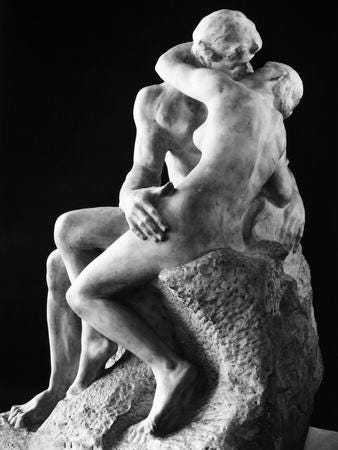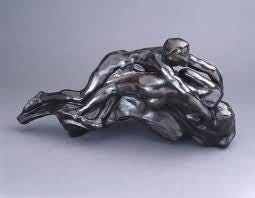This is Paulo and Francesca as imagined by Auguste Rodin. Their adulterous story is recorded by Dante in Inferno 5, the circle of the lustful. Francesca recounts what happened:
“We read one day for pastime of Lancelot, how love constrained him. We were alone and had no misgiving. Many times that reading drew our eyes together and changed the colour in our faces, but one point alone it was that mastered us; when we read that the longed-for smile was kissed by so great a lover, he who never shall be parted from me, all trembling, kissed my mouth. A Galeotto was the book and he that wrote it; that day we read in it no farther.”
This affair happened in Dante’s lifetime and led to the lovers’ deaths when Paulo’s brother, Francesca’s husband, discovered them together.
In his poetic retelling of the adultery’s beginning, Dante establishes narrative tension by contrasting reading and lovemaking: “we read one day for pastime of Lancelot, how love constrained him.” The subject matter is tinder, but Dante doesn’t rush things.
Let’s follow the sequence of Francesca’s simple statement. The act of reading between a man and a woman known in hindsight to have been lovers suggests deferral and an attempt, however disingenuous, to redirect energies away from passion. Reading is implicitly its opposite. It suggests the difference between bookish knowledge and experiential knowledge.
The medieval English poet Geoffrey Chaucer, much influenced by Dante, exploits this difference in his love poem The Parliament of Fowls, in which he alludes to the Inferno (though not directly to Francesca’s story). The narrator of Chaucer’s poem doesn’t tell us why he’s not a candidate for love himself, but apparently he’s not. He reads to learn about it, with no prospect of experiencing it himself. Given his condition, his reading makes him an example of the difference between knowing something and merely knowing about it. In the realm of courtly romance, this binary reduces to a stark opposition between knowledge and love, reason and passion. Paolo and Francesca’s act of reading sets up a contrast with what unfolds.
The subject of their reading, the story of Lancelot, itself trades on the paradoxical relationship between love and reason. It also further embeds it in Western European culture. In this story, Lancelot abases himself for the sake of Queen Guinevere, who has been abducted and taken prisoner. He loves her even though she is the wife of his king, King Arthur. At one point in his frantic search for her, having ridden two horses to death, he allows himself to be subjected to the humiliation of being carried in a prisoner’s cart to where the queen is being held.
There’s an internal logic: Lancelot is following (or establishing) the rules of courtly love in being willing to do anything to reach his beloved. Outside its dictates, his actions make no sense: he is contravening the chivalric code of conduct. When he reaches her, Guinevere is insulted by a momentary hesitation to get into the cart that Lancelot displayed and which she learns about, though she later forgives him. She expects him to be willing without thinking to make a fool of himself as a sign of his utter devotion to her.
As a footnote to this story, in one reading of the cycle of Arthurian tales, the whole kingdom comes crashing down because of Lancelot and Guinevere’s adulterous passion. More specifically, events come to a head when Mordred blabs about the affair in court. Now everybody knows, including Arthur, that everybody knows about it; he is forced to act. The entire story of the politics of Logres has built into it a tension between an order of knowledge and law, on the one hand, and the law of passion on the other.
Love, like violence, is an irrational passion that takes them prisoner.
As for Paulo and Francesca, they are alone, they have no misgivings, they are “mastered.” Dante’s word is vinse, conquered. Love, like violence, is an irrational passion that takes them prisoner. Paulo and Francesca become subject to its demands, regardless of the cost to family stability and public honour. For Francesca, the telling of what happened ends with one last reference to reading: “we read no more that day.” Reading serves as a contrast, establishes tension, and finally, as not-reading, becomes a euphemism for the opposite activity of lovemaking.
Rodin captures this tension exquisitely. He imagines these lovers in several different ways.
The sculptures brim with vitality and sensuality. Sculpture, as a form of representation, has a particular inbuilt challenge that involves the reconciliation or proper ordering of reason and passion: how does one release the emotional energy of what looks objectively to be a block of matter?
The Frenchman understands the importance of the reading. In “The Kiss,” he includes the book that is being discarded. The three-dimensionality of this art form affords him a certain opportunity. We can see the presence of the book clearly in the image at the head of this article. Changing media involves interpretive choices. Going from sculpture to image in the following picture unfortunately obscures the book, though one can appreciate the precise attention paid by the photographer to the artistic desiderata of balance and symmetry.
In “The Kiss,” rationality – in one way, at least – is being left behind. For the sculptor Rodin, it nonetheless figures in and contributes to the dynamism of the scene as art. The work transposes a basic but compelling tension in Dante’s own art. Both the poetic and sculpted enactments of the cultural construct of love and reason in tension help us participate in the lovers’ experience itself: their sense of family honour, remembered intonations of the priest, the weight of the room, marital slights real and imagined, fraternal fractures, and very present, very real desire.





